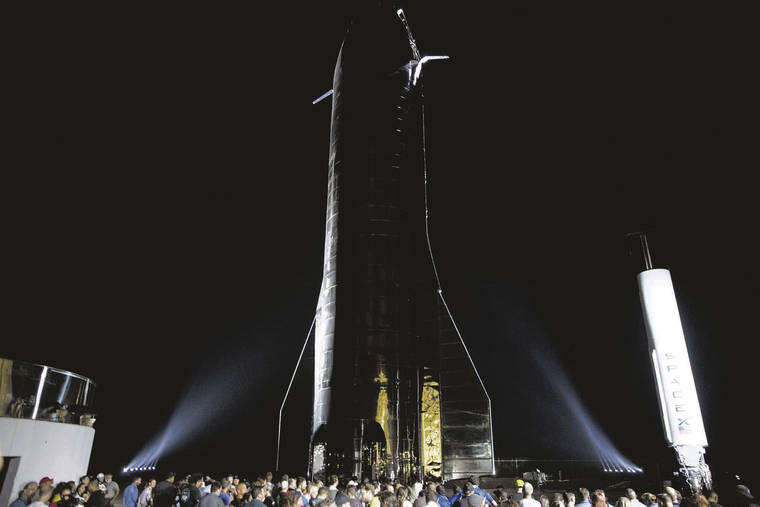Elon Musk’s SpaceX wants to fly its big Starship from a launch in Texas to a splashdown 62 miles northwest of Kauai — a trip most of the way around the world in just 90 minutes — in the first orbital test of the transport planned to carry cargo and crew to Earth orbit, the moon and Mars.
An application filed Thursday with the Federal Communications Commission seeks a communications license for an “experimental orbital demo and recovery test of the Starship test vehicle” launching from the SpaceX center in Boca Chica, Texas.
The booster stage will separate approximately 170 seconds into flight and then perform a touchdown — possibly on a floating platform — in the Gulf of Mexico 20 miles from shore.
Four Starship suborbital flights ended with explosions before a fifth flight landed successfully May 5 at what SpaceX calls Starbase in Texas.
For the orbital test, the company known for the reuse of spacecraft plans to stack a payload section atop a Super Heavy rocket creating, in this case, a nearly 400-foot-tall uncrewed Starship.
The orbital part of the Starship — which eventually will be able to carry a crew and 100-plus tons of equipment — will fly between the Florida Straits and head around much of the planet before making what SpaceX hopes is a “soft ocean landing” northwest of Kauai.
Test-heavy SpaceX recognizes the inherent uncertainty with the first orbital test and is opting for the ocean splashdown versus a platform landing.
“SpaceX intends to collect as much data as possible during flight to quantify entry dynamics and better understand what the vehicle experiences in a flight regime that is extremely difficult to accurately predict or replicate computationally,” it said in the FCC filing.
Musk tweeted Thursday, “We need to make sure ship won’t break up on reentry, hence deorbit over Pacific.”
Kauai is the northernmost of the main Hawaiian Islands. Modeling of the spacecraft’s flight shows it passing north of the other major islands should it miss its landing mark.
Musk, SpaceX’s chief executive officer, tweeted in March that it was his goal to conduct the orbital flight by July 1. The “requested period of operation” filed with the FCC is June 20 to Dec. 20.
But a lot of regulatory compliance remains.
SpaceX has to obtain a permit from the Federal Aviation Administration, and in March the agency said it was preparing a draft environmental assessment.
Ted Ralston, a retired aerospace engineer, said “Hawaii should be celebrating” its planned role in the Starship’s first orbital test flight.
The Honolulu resident said it’s a return of the type of U.S. manned operations in space that “have been silent for about 10 years, ever since the (space) shuttle was grounded. And it’s something that can inspire people to think about the future — just like the Apollo program.”
“It’s also, in my mind, highlighting a new dimension here of commercial activity — not government activity — in space,” Ralston said. “SpaceX is commercial, and it was done by private investment, not U.S. investment, and it’s moving very fast and moving very safely, and it’s a step up, frankly.”
In April, NASA said it had selected SpaceX to continue development of the first human lander to carry the next two American astronauts to the lunar surface as part of its Artemis program.
NASA said it will launch four astronauts aboard an Orion spacecraft for the multiday journey to lunar orbit, and from theretwo will transfer to the SpaceX Starship human landing system for the final leg to the surface of the moon.
The firm-fixed price for the milestone-based contract total award value is $2.89 billion, NASA said.
“Starship includes a spacious cabin and two airlocks for astronaut moonwalks,” the agency said. “The Starship architecture is intended to evolve to a fully reusable launch and landing system designed for travel to the Moon, Mars and other destinations.”
At least one of those astronauts will make history as the first woman on the moon, NASA said. Another NASA goal of the Artemis program includes landing the first person of color on the lunar surface.

